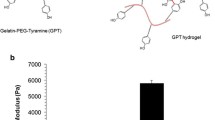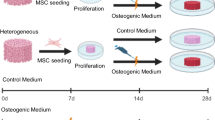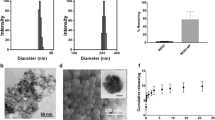Abstract
Purpose
Three-dimensional fibrous scaffolds provide an environment that enhances transplanted stem cell survival in vivo and facilitates imaging their localization, viability, and growth in vivo. To assess transplanted stem cell viability on biocompatible polymer scaffolds in vivo, we developed in vivo imaging systems for evaluation of implanted viable neural stem cells (NSC) and mesenchymal stem cells (MSC) on scaffolds using luciferase or sodium/iodide symporter (NIS) genes.
Methods
Firefly luciferase stably expressing-C6 cell was established (C6-Fluc). The human neural stem cell, F3, was infected with adenoviral vector carrying luciferase gene (F3-Fluc) and MSC expressing NIS controlled by ubiquitin C promoter using lentiviral vector was established by treating blasticidine for 2 weeks (MSC-NIS). Chitosan and poly l-lactic acid (PLLA) scaffolds were used for in vivo image. In vivo expression of luciferase and human NIS was examined by bioluminescence image or 99mTc-pertechnetate gamma camera image, respectively. The cell/scaffold complex was implanted into subcutaneous or abdominal area of BALB/C nude mouse. For quantitative evaluation of cell viability, regions of interest were drawn on 99mTc-pertechnetate scintigraphy by manual.
Results
The gradual increase of luciferase activity was observed in C6-Fluc seeded with chitosan according to the increase in the number of cells. C6-Fluc/chitosan complex subcutaneously implanted into nude mice showed longitudinal bioluminescence image until 34 days. Luciferase image of abdominal-injected C6-Fluc/PLLA complex was saturated in only 14 days, showing great cell growth due to abundant nutrients. F3 cells showed well-incorporated pattern with fibrous chitosan scaffold using scanning electron microscopy. F3 infected with Ad-Fluc showed >100-fold higher luciferase activity than luciferase activity in F3. Cell-number-dependent increase of luciferase activity was shown in F3-Fluc seeded on chitosan. F3-Fluc incorporation into chitosan after abdominal injection was clearly visible on bioluminescence image up to 11 days. Radionuclide imaging showed higher uptake by MSC-NIS on PLLA scaffolds than by MSC-NIS not seeded on a scaffold. Quantitative data showed significantly better survival of MSC-NIS on PLLA scaffolds than without scaffold at 72 h post-implantation, which concurred with histologic findings.
Conclusion
These results suggest that NSC-Fluc and MSC-NIS cells incorporated within polymer scaffolds can be monitored on a long-term basis by serial in vivo imaging. We believe that a biocompatible scaffold-based imaging system could be used to assess stem cell viabilities in a non-invasive way to aid the development of regenerative therapeutics.







Similar content being viewed by others
References
Langer R, Vacanti JP. Tissue engineering. Science 1993;260:920–6.
Griffith LG, Naughton G. Tissue engineering: current challenges and expanding opportunities. Science 2002;295:1009–14.
Shi C, Zhu Y, Ran X, Wang M, Su Y, Cheng T. Therapeutic potential of chitosan and its derivatives in regenerative medicine. J Surg Res 2006;15:185–92.
Boo JS, Yamada Y, Okazaki Y, Hibino Y, Okada K, Hata K, et al. Tissue-engineered bone using mesenchymal stem cells and a biodegradable scaffold. J Craniofac Surg 2002;13:231–9.
Hammond JS, Beckingham IJ, Shakesheff KM. Scaffolds for liver tissue engineering. Expert Rev Med Devices 2006;3:21–7.
Liu W, Cui L, Cao Y. Bone reconstruction with bone marrow stromal cells. Methods Enzymol 2006;420:362–80.
Silva GA, Czeisler C, Niece KL, Beniash E, Harrington DA, Kessler JA, et al. Selective differentiation of neural progenitor cells by high-epitope density nanofibers. Science 2004;303:1352–5.
Park KI, Teng YD, Snyder EY. The injured brain interacts reciprocally with neural stem cells supported by scaffolds to reconstitute lost tissue. Nat Biotechnol 2002;20:1111–7.
Evans GR, Brandt K, Niederbichler AD, Chauvin P, Herrman S, Bogle M, et al. Clinical long-term in vivo evaluation of poly(l-lactic acid) porous conduits for peripheral nerve regeneration. J Biomater Sci Polym Ed 2000;11:869–78.
Yang F, Murugan R, Wang S, Ramakrishna S. Electrospinning of nano/micro scale poly(l-lactic acid) aligned fibers and their potential in neural tissue engineering. Biomaterials 2005;26:2603–10.
Lee JY, Nam SH, Im SY, Park YJ, Lee YM, Seol YJ, et al. Enhanced bone formation by controlled growth factor delivery from chitosan-based biomaterials. J Control Release 2002;78:187–97.
Suh JK, Matthew HW. Application of chitosan-based polysaccharide biomaterials in cartilage tissue engineering: a review. Biomaterials 2000;21:2589–98.
Chung JK. Sodium iodide symporter: its role in nuclear medicine. J Nucl Med 2002;43:1188–200.
Kang JH, Lee DS, Paeng JC, Lee JS, Kim YH, Lee YJ, et al. Development of a sodium/iodide symporter (NIS)-transgenic mouse for imaging of cardiomyocyte-specific reporter gene expression. J Nucl Med 2005;46:479–83.
Ourednik V, Ourednik J, Flax JD, Zawada WM, Hutt C, Yang C, et al. Segregation of human neural stem cells in the developing primate forebrain. Science 2001;293:1820–4.
Scoof H, Apel J, Heschel I, Rau G. Control of pore structure and size in freeze dried collagen sponges. J Biomed Mater Res 2001;58:352–7.
Mikos AG, Thorsen AJ, Czwerwonka LA, Bao Y, Langer R. Preparation and characterization of poly(l-lactic acid) foams. Polymer 1994;35:1068–77.
Kosugi S, Sasaki N, Hai N, Sugawa H, Aoki N, Shigemasa C, et al. Establishment and characterization of a Chinese hamster ovary cell line, CHO-4J, stably expressing a number of Na+/I− symporters. Biochem Biophys Res Commun 1996;227:94–101.
Bensaïd W, Triffitt JT, Blanchat C, Oudina K, Sedel L, Petite H. A biodegradable fibrin scaffold for mesenchymal stem cell transplantation. Biomaterials 2003;24:2497–502.
Elçin YM, Dixit V, Lewin K, Gitnick G. Xenotransplantation of fetal porcine hepatocytes in rats using a tissue engineering approach. Artif Organs 1999;23:146–52.
Hutmacher DW, Goh JC, Teoh SH. An introduction to biodegradable materials for tissue engineering applications. Ann Acad Med Singapore 2001;30:183–91.
Madihally SV, Matthew HW. Porous chitosan scaffolds for tissue engineering. Biomaterials 1999;20:1133–42.
Chen VJ, Ma PX. Nano-fibrous poly(l-lactic acid) scaffolds with interconnected spherical macropores. Biomaterials 2004;25:2065–73.
Yamaguchi M, Shinbo T, Kanamori T. Surface modification of poly(l-lactic acid) affects initial cell attachment, cell morphology, and cell growth. J Artif Organs 2004;7:187–93.
Liu X, Won Y, Ma PX. Porogen-induced surface modification of nano-fibrous poly(l-lactic acid) scaffolds for tissue engineering. Biomaterials 2006;27:3980–7.
Ma Z, Gao C, Gong Y, Shen J. Cartilage tissue engineering PLLA scaffold with surface immobilized collagen and basic fibroblast growth factor. Biomaterials 2005;26:1253–9.
Li J, Pan J, Zhang L, Yu Y. Culture of hepatocytes on fructose-modified chitosan scaffolds. Biomaterials 2003;24:2317–22.
Ho MH, Hou LT, Tu CY, Hsieh HJ, Lai JY, Chen WJ, et al. Promotion of cell affinity of porous PLLA scaffolds by immobilization of RGD peptides via plasma treatment. Macromol Biosci 2006;6:90–8.
Levenberg S, Huang NF, Lavik E, Rogers AB, Itskovitz-Eldor J, Langer R. Differentiation of human embryonic stem cells on three-dimensional polymer scaffolds. Proc Natl Acad Sci USA 2003;100:12741–6.
Taqvi S, Roy K. Influence of scaffold physical properties and stromal cell coculture on hematopoietic differentiation of mouse embryonic stem cells. Biomaterials 2006;27:6024–31.
Acknowledgments
We thank Dr. Sang Hee Kim of the Asan Medical Center, Seoul, South Korea for generously donating the rat mesenchymal stem cells. This work was supported by Nano Bio Regenomics Project of Korean Science and Engineering Foundation and by Innovation Cluster for Advanced Medical Imaging Technology. This study was made easier using KREONET, Korean Research Network, a nation-wide Giga-bps network system.
Author information
Authors and Affiliations
Corresponding authors
Additional information
Soonhag Kim and Dong Soo Lee contributed equally to this investigation as corresponding authors and Do Won Hwang and Sung June Jang equally contributed as co-first author.
Electronic supplementary material
Below is the link to the electronic supplementary material.
Supplementary Table 1
CMCs of 99mTc-pertechnetate uptake at the implantation sites of MSC-NIS with scaffold and MSC-NIS without scaffold. Repeated measurement ANOVA revealed a significant difference between CMCs of MSC-NIS with scaffold and MSC-NIS without scaffold (p = 0.034) (DOC 50.0 KB)
Supplementary Table 2
Ratio of corrected maximum counts on MSC injection site and control area. The paired t test showed no significant difference between groups (DOC 28.5 KB)
Supplementary Table 3
Ratio of corrected maximum counts on scaffold alone and control area. The paired t test showed no significant difference between groups (p > 0.05) (DOC 28.0 KB)
Supplementary Fig. 1
C6 glioma cells stably expressing luciferase showed much higher luciferase activity than parental C6 cells. The values are mean ± SD of tetraplicate wells (GIF 67.2 KB)
Supplementary Fig. 2
The 2 × 106 C6-Fluc cells seeded on a PLLA scaffold were implanted intraperitoneally. Summed activities in C6-Fluc/PLLA complex of peritoneal cavities (region B of Fig. 1c) were quantified, and their time courses were shown (GIF 76.4 KB)
Supplementary Fig. 3
F3-Fluc cells showed markedly higher luciferase activity than in parental F3 cells at 48 h after infecting F3 with Ad-Fluc vector (GIF 70.8 KB)
Supplementary Fig. 4
On these microplate images, luciferase activities gradually increased in F3-Fluc/chitosan scaffolds as cell numbers were increased. Initially administered number of cells was comparable to the final activities in cell–scaffold complexes in vitro. Linearity was preserved up to the cell density of 1 × 106 cells/well (GIF 105 KB)
Supplementary Fig. 5
NIS activity in MSC infected with NIS using a lentiviral system was higher than in parental MSC cells (black bar), and KClO4 completely inhibited NIS expression (white bar) (GIF 70.1 KB)
Supplementary Fig. 6
MSC-NIS was implanted to three or four subcutaneous areas of these mice. These are co-registered images showing ROIs used for quantitative analyses. A: MSC-NIS–PLLA scaffold complex was implanted surgically in right flanks. B: MSC-NIS cells without scaffold were injected subcutaneously using a 22 G needle. C: PLLA scaffold alone without cells was implanted subcutaneously. In the mice 1, 3, and 5, on the left scapular area opposite to region C, MSC without NIS was injected subcutaneously as a negative control (GIF 119 KB)
Supplementary Fig. 7a
To the seven mice, MSC-NIS–scaffold complex and MSC-NIS cells without scaffold were implanted. The number of implanted cells was varied for each mouse (1a, 1b: 3 × 106; 2a, 2b: 6 × 106; 3a, 3b: 9 × 106; 4: two scaffolds with 3 × 106cells. In addition to normal thyroid, stomach, and occasional bladder uptakes, the 99mTc-pertechnetate uptake on the implanted sites by MSC-NIS were shown repeatedly imaged from 3 to 72 h post-implantation. MSCs without NIS were implanted in the left scapular area of subjects 1a, 2a, and 3a (GIF 309 KB)
Supplementary Fig. 7b
(GIF 256 KB)
Rights and permissions
About this article
Cite this article
Hwang, D.W., Jang, S.J., Kim, Y.H. et al. Real-time in vivo monitoring of viable stem cells implanted on biocompatible scaffolds. Eur J Nucl Med Mol Imaging 35, 1887–1898 (2008). https://doi.org/10.1007/s00259-008-0751-z
Received:
Accepted:
Published:
Issue Date:
DOI: https://doi.org/10.1007/s00259-008-0751-z




